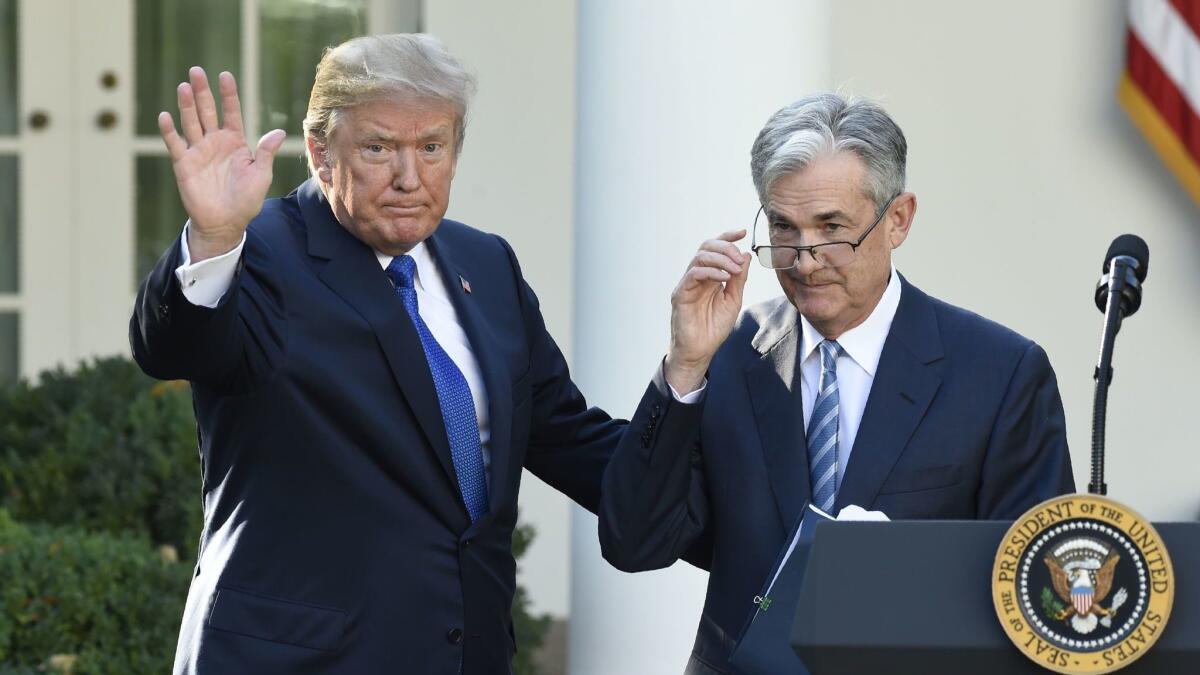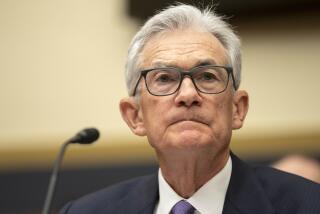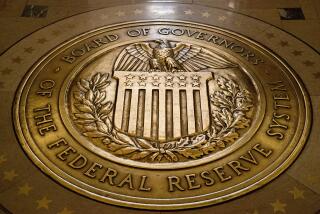Trump’s complaint that the Federal Reserve was ‘going loco’ on interest rates is just plain crazy, analysts say

The stock market tumbled Thursday for a second-straight session — a combined loss of nearly 1,400 points by the Dow Jones industrial average — and President Trump has been quick to finger the culprit:
The Federal Reserve, headed by his handpicked chairman, Jerome H. Powell.
“We have interest rates going up at a clip that’s much faster than certainly a lot of people including myself would have anticipated,” Trump told reporters Thursday, continuing the rare presidential criticism he started this summer of the independent central bank.
“I think the Fed is out of control. I think what they’re doing is wrong,” he said. On Wednesday, Trump was more pointed, saying the Fed “has gone crazy,” is “going loco” — and he’s “not happy about it.”
But Fed officials have been doing exactly what they’ve publicly signaled for months: slowly raising a key interest rate in the face of stronger economic growth.
So blaming the Fed for the market dive is just plain nuts, analysts said.
“I think the Fed is actually the only policymaking institution in Washington that has not gone crazy,” said Alice M. Rivlin, a senior fellow at the Brookings Institution think tank.
“It’s been conducting monetary policy in a very methodical and transparent way, slowly and deliberately explaining what they’re doing in excruciating detail,” said Rivlin, a former Fed policymaker. “The Fed is an island of sanity.”
Bigger factors in Wednesday’s 832 point drop in the Dow and an additional decline of 546 points on Thursday are the large tax cuts — which increased the borrowing needed by the U.S. government to offset lost revenue — and a trade war with China, said Diane Swonk, chief economist at accounting and advisory firm Grant Thornton.
Both are Trump’s own doing, not the Fed’s.
“They don’t determine fiscal policy. They don’t determine trade policy,” she said. “They have to react to those shifts.”
The recent financial market downturn was triggered in part by investors worried about a jump in long-term interest rates, which make it more expensive for consumers to take out mortgages and corporations to issue bonds to borrow money for expansion.
The yield on benchmark 10-year Treasury bonds, which was 2.82% in late August, jumped to as high as 3.24% on Wednesday. It closed Thursday at 3.15%.
But the Fed doesn’t control the 10-year interest rates.
The central bank’s benchmark federal funds rate is a short-term one. Banks use it to determine rates for credit cards, car loans, small business loans and home equity lines of credit.
The Fed moves the rate to try to slow or accelerate economic growth. A rising short-term rate is an acknowledgement of economic improvement, which can be a good sign for investors. But an increase also can signal slower growth ahead because it indicates the Fed is trying to tap the brakes on the economy.
Although there is no direct effect on long-term rates, they do generally follow changes in the fed funds rate because investors take cues from the Fed about the economy’s direction.
“We were expecting long-term yields to go up, and it just took awhile,” Swonk said.
The delay can come because the 10-year rate is set by market conditions, said Jack Ablin, chief investment officer at Cresset Wealth Advisors, an investment advisory firm. Other factors can also come into play.
“You can blame the deficit for a lot of this move,” Ablin said.
The Republican tax cuts, a top Trump priority, took effect this year. They slashed corporate and individual rates, causing tax revenues to drop as government expenditures — boosting military spending is another Trump priority — are increasing.
The Congressional Budget Office forecasts the tax law will add $1.9 trillion to the national debt by 2028. The Treasury Department has had to borrow more money to finance the debt.
Treasury officials said this summer they expected to borrow $769 billion in the second half of this year, the most since 2008. To do that, they need to auction off more bonds and boost the interest rate to lure buyers.
Compounding the problem is the U.S. trade war with China.
The Trump administration has slapped tariffs on about $250 billion of Chinese imports. China has retaliated with tariffs on $60 billion of U.S. goods. Both sides have threatened to escalate the fight.
The tariffs have raised investor fears of slower growth in both countries. On top of that, the tariffs have hurt China’s economy, reducing its demand for buying U.S. Treasury bonds.
“China is slowing its purchase of Treasury bonds, not just to penalize us but because of its own economy,” Swonk said. “In the end, you’ve got a lot of supply with less demand.”
The tax cuts also have fueled stronger U.S. economic growth. The economy grew at a 4.2% annual rate in the second quarter of the year, the fastest since 2014.
Although the pace is expected to slow in the second half of the year, the faster growth has put pressure of the Fed to raise its short-term rate to try to prevent the economy from expanding so quickly that it causes inflation to jump.
Inflation has been rising as growth has accelerated and has topped the Fed’s target of 2% a year, fueling the central bank’s desire to inch up rates — though by one measure, the consumer price index, inflation slowed last month, dropping the year-over-year increase to 2.3%. It was 2.9% in July.
Still, because of recent economic conditions, the rate increases shouldn’t have been a surprise. After inching the rate up 0.25 percentage point in March, Fed officials said a stronger U.S. economy could mean a slightly faster pace of interest rate hikes.
They forecast then that there would be a total of three rate increases this year, and said they could add a fourth. Then in June, they forecast a fourth increase after the year’s second boost. Fed officials reiterated that forecast in September after making the year’s third 0.25 percentage point hike.
The market downturn “isn’t the Fed’s fault. The Fed is doing what it said it would do,” Swonk said.
“Financial markets haven’t always listened,” she said, acknowledging investors might not have believed the Fed would go through with its planned rate increases.
The Fed’s key rate still is historically low. After last month’s boost, the target range is between 2% and 2.25%. Economists said it should be much higher given the current economic conditions. It’s high in the last economic expansion in the mid-2000s was 5.25%.
Even so, Trump said Thursday that the Fed was raising interest rates too quickly.
“It’s not necessary, in my opinion. And I think I know about it better than they do, believe me,” he said.
But when asked by a reporter in the Oval Office if he would dismiss Powell, Trump said, “No, I’m not going to fire him.”
That would be very difficult for Trump to do even if he wanted to.
No Fed chair has ever been removed by a president, though Chairman Thomas B. McCabe was forced to resign in 1951 under White House pressure after clashing with President Truman’s administration.
“We all know the Fed is independent,” Larry Kudlow, Trump’s top economic advisor, told CNBC Thursday. “The president is not dictating policy to the Fed.”
The reality is, the president has little leverage.
The Fed is independent of the White House. Unlike Cabinet officials and most other executive branch employees, the central bank’s chairman and members of its board of governors do not serve at the will of the president.
The Federal Reserve Act, which created the central bank in 1913, states that Fed board members can only be “removed for cause” by the president before their term expires. Powell’s term as chairman ends in 2022 and his term as a governor ends in 2028.
The law does not define “for cause,” a term that applies to officials in other independent agencies, such as the Federal Trade Commission. In a 1935 case involving President Franklin D. Roosevelt’s removal of an FTC commissioner, the Supreme Court ruled that such officials could not be fired for political reasons.
Powell’s leadership of the Fed since taking over in February has drawn praise from economists and financial analysts. He’s indicated that he and his colleagues are not affected by Trump’s criticism.
“I think the Fed is doing exactly what they’re supposed to be doing,” Ablin said, “and President Trump is looking for something to blame.”
Twitter: @JimPuzzanghera







